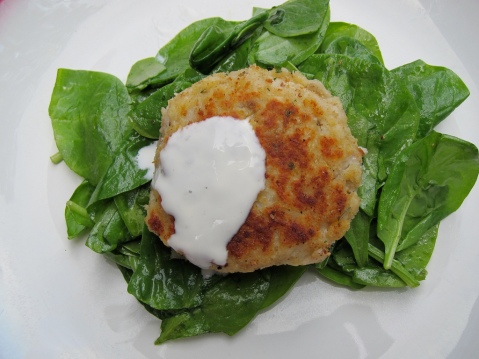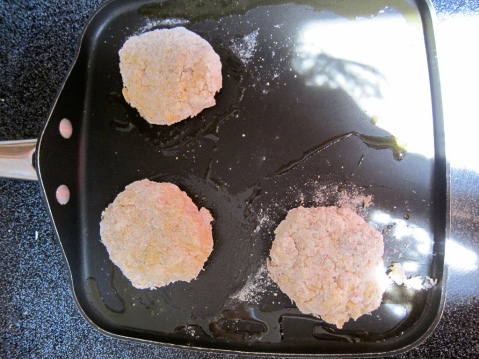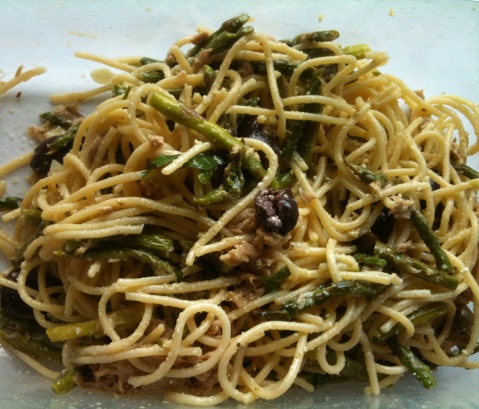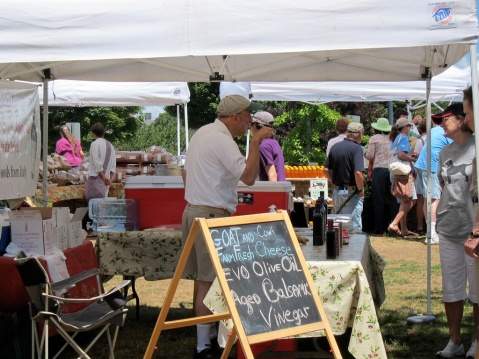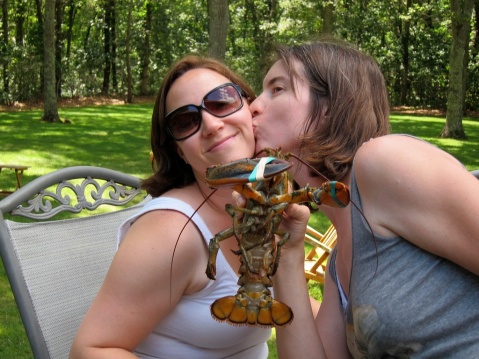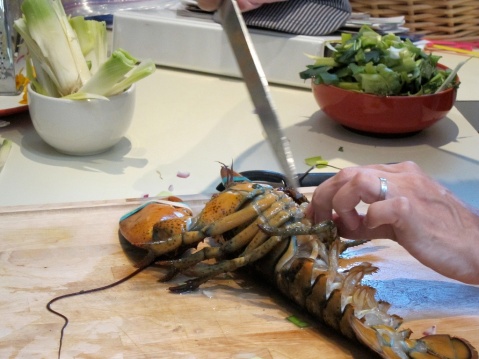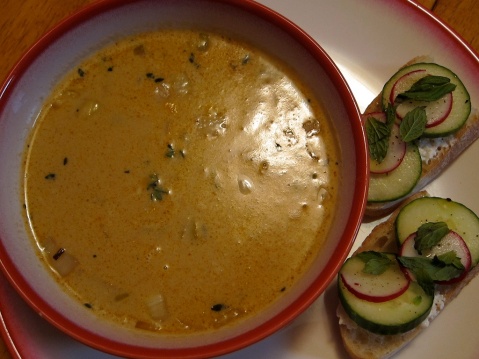Fish Cakes with Lime Aioli and Spinach Salad
On Sunday, I volunteered for Slow Food Chicago‘s annual pig roast fundraiser at Goose Island Brewery. About a dozen local chefs presented their pork offerings to the hungry foodie throng. Beer flowed freely. The brewers gave tours of their grounds. A whole pig trunk was stuffed with a sausage made from its legs. I ate such things as mole tostadas and roasted pork atop of sous vide watermelon. Several chefs were grilling on the brewery’s loading deck and serving ribs and truffle-oil sausages with foie gras. Even many vegetarians I talked to sampled the offerings at this meat parade because they could be sure, in this company, that the meat was responsibly and locally raised.
I learned a lot about the organization too. Not only do they support sustainable practices, they support pleasurable practices. Slow food can certainly be more more healthful, more responsible–but also, just more enjoyable. There was so much invested in this event–from the chefs, the organization, the volunteers, the participants. Truly, people seemed happy to be there. Well-fed and well-meaning.
In that vein, let’s talk recipe. This is SUCH a delicious reuse of leftovers. I used scrod in these fish cakes because it was on hand from grilled fish tacos the night before. This was a collaborative meal: my recipe, collective labor, collective enjoyment. It hit high on the food pleasure scale–made with friends, shared with friends, and completely delicious.
Fish Cakes with Lime Aioli
1 lb. cooked fish (We used scrod, grilled.)
1 can chickpeas, drained and rinsed
1 c. flour
2 eggs, lightly beaten
salt and pepper
1/2 c. breadcrumbs
1/4 c. olive oil
2 tbsp. butter
Place the fish in a large bowl and use a fork to flake it. Add the chickpeas and roughly mash. Cover with 1/2 c. flour, then add the eggs and salt and pepper (about 1 tsp each). Mix together until thoroughly combined.
In a separate bowl, combine the rest of the flour, the bread crumbs, and salt and pepper. Take a handful of the fish-chickpea mixture and roll into a ball. Roll the fish ball in the breadcrumbs and flour mix, then set aside. Continue this process until all the fish mixture is gone.
Coat a pan with 1/4 c. olive oil and 2 tbsp. of butter, then bring to high heat. Fry the fish cakes (while gently smashing into discs) until each side is a golden brown and it’s cooked through, about four minutes per side. Serve over a spinach salad with a lime aioli, recipes to follow.
Lime Aioli
1 lime
1/8 c. mayonnaise
1/4 c. sour cream
salt and pepper
Combine the mayonnaise and sour cream with the juice of the lime. Add salt and pepper and adjust seasonings to taste. Drizzle over the fish cakes.
Spinach Salad
1 c. baby spinach per cake
Create a vinaigrette using:
1/4 c. olive oil
2 limes
1 tbsp. apple cider vinegar
pepper
Combine the vinaigrette ingredients in a processor, then dress the spinach. Serve the cakes on top of the spinach.
These are the hands that mixed the fish cakes.
Tuna and Asparagus Pasta Salad
A good work lunch is a wonderful thing. It’s summer, the sun is shining out there outside my window, and no one wants to be stuck in the office. By no one, I mean me. But lunch helps. It takes me out of email-land and puts me under a tree in the quad, with ample passerby traffic and a good book to entertain me.
Pasta salads are quintessential summer food for me. Picnic-friendly, veggie-laden, and simple. What more do you need? Besides a patch of grass and a shady tree, of course.
Tuna and Asparagus Pasta Salad
1 lb. pasta (I used spaghetti)
1 can tuna (your choice; I used light, packed in water), drained
2 tbsp. dijon mustard
2 tbsp. red wine vinegar
salt and pepper
1 garlic clove, whole, with skin on
1 bunch of asparagus
olive oil
6 oz. kalamata olives
1 oz. capers
goat cheese
zest of 1 lemon
parmesan cheese
basil, julienned
Preheat oven to 425 degrees.
Bring a pot of salted water to a boil and then add your pasta.
Rinse asparagus, snap off ends, and then cut them into inch-long pieces. Arrange in a single layer on a cookie sheet, and throw the garlic clove on there. Drizzle with olive oil and salt and pepper. Put in the oven to roast at the same time you put the pasta in the water. When the pasta is done, the asparagus should be perfectly roasted. Take a peek at them during the process to make sure they are not getting overdone (cooking times will vary with the thickness of the asparagus. By the way, try to get the super thin ones–they are amazing).
In a large bowl, combine tuna, mustard, vinegar, salt, and pepper. Mash together with a fork until thoroughly combined. Add the olives, capers, and roasted asparagus to the bowl and set aside.
When the pasta is cooked to al dente, drain and add to the existing bowl. Coat with olive oil and then combine with the other ingredients. Add the goat cheese, parmesan, lemon zest, basil, and 2-3 pinches of salt. Peel the skin off the roasted garlic and smash with a mortar and pestle. Add to the bowl. Toss everything together until well combined, making sure that the smashed garlic is distributed throughout.
I prefer to serve this cold, so put in the fridge and bring it to lunch the next day!
Christine’s Lobster Bisque, with Open-Faced Cucumber Sandwiches
More Cape Cod delights (I’m telling you, we ate well on this trip). After our clam bake, we had the quick sense to make a seafood stock with the clam and lobster shells. Which led to lobster bisque…of course. This could also be made with crab meat if you were short on lobster.
The sammiches were inspired by the farmers’ market in Falmouth. We bought goat cheese that had been made at 5:30 AM that very day. It was mild and luscious. I hadn’t ever associated the sour tang of goat cheese with the aging process, but this fresh goat cheese was milder than mozzarella. We layered it on ciabatta, topped with cucumber and radish rounds, olive oil, mint leaves, salt, and pepper. A perfect bright counterpoint to the creamy soup. This is the goat cheese seller.
We got the lobster from the market, too.
Lobster made everyone happy.
Well, except for Mr. Lobster. Christine had to kill him before cooking, and, though she did so with incredible skill and aplomb (following instructions she’d seen on the Food Network), he still twitched. A lot. For a long time. Poor guy. Poor, tasty, little guy.
Here’s Christine’s recipe for this gorgeous soup, and the story behind it:
I grew up in New England, and lobster was a frequent and popular treat. It was usually the most basic and pure variety – boiled or steamed, with lots of butter and few gourmet touches. So I was not familiar with lobster bisque.
In college, my roommate was a foodie from Singapore, named shimi. She was an expert in the spiciest type of Indian cooking (new to me!), and eager to try out new styles. Since shimi’s home was far away, we invited her to my house for many holidays, and she quickly became an honorary part of the family.
One Christmas we introduced shimi to skiing. After she got her confidence up, she tackled the bunny slope, while I went off to try some steeper stuff. Unfortunately, both of us met disaster, and we reunited in the infirmary with identically sprained knees. Yet, despite our handicaps, we were determined to make something scrumptious for Christmas. So we took on lobster bisque for the first time. I have vivid memories of us hobbling around the kitchen on crutches, completing the many steps of this gourmet soup. It was delicious!
Following our Cap Code clambake, when confronted with a bucket of lobster shells, I knew it had to be done – lobster bisque, 17 years later! Eager to save the essence of our clambake, we combined the remaining broth with the lobster shells, more water, and a chopped up onion, and simmered it for a few hours. Then we stored the results in the fridge until we had an afternoon free to cook.
Lobster Bisque
(adapted from http://www.foodnetwork.com/recipes/tyler-florence/lobster-bisque-recipe/index.html)
Broth from a clambake (water from steaming, lobster shells, water, and an onion, simmered for a few hours)
1 lobster
3 tbsp olive oil
3 tbsp unsalted butter
Greens from 2 leeks
1 roughly chopped onion
4 peeled and chopped red potatoes
6 sprigs fresh thyme
4 strips orange zest
2 tbsp tomato paste
¼ cup cognac
3 tbsp all-purpose flour
3 cups heavy cream
Dispatch the lobster by plunging a sharp knife directly behind its head. Cut the lobster in half lengthwise. Remove the claws and tail pieces and set aside. Remove the head sac and liver and discard them; cut the body into pieces.
(A bit of a warning – the lobster was still squirming long after the above steps. Not for the faint of heart.)
Heat the olive oil in a large pot over medium heat and melt the butter in it. Add the chopped lobster body and head, the leek greens, onion, thyme, orange zest and the tomato paste. Cook until the shells are red and the vegetables are soft, about 10 to 15 minutes. Remove the pot from the heat and carefully pour in the cognac. Ignite the cognac with a long kitchen match and let the alcohol burn off. Return to the heat, sprinkle in the flour, stir, and cook for another 2 minutes. Add broth to cover and stir up all the browned bits on the bottom of the pot with a wooden spoon. Add the cream and bring to a boil. Immediately decrease the heat and gently simmer until the soup is reduced and thickened, about 30 to 45 minutes. Strain this into a clean pot and season with salt and pepper if needed. Fish out the cooked potato and mash into broth to thicken further.
Lobster claws and tail
2 tbsp olive oil
2 tbsp butter
Whites from 2 leeks, finely chopped
2 sprigs thyme
1 tsp orange zest
¼ cup cognac
Pre-heat the oven to 400 degrees F. Heat the olive oil and butter in an ovenproof skillet over medium heat. Add leeks, thyme, and orange zest along with the some freshly ground pepper and let this mixture cook for about 5 minutes. Add the lobster claws and tail; toss to coat with the fat and flavors. Remove the pan from the heat and carefully pour in the cognac. Ignite the cognac with a long kitchen match and let the alcohol burn off. Put the pan into the oven and roast until the lobster pieces are cooked through, about 15 minutes. Remove the lobster pieces and set aside. When they are cool enough to handle, remove the lobster meat from the claws and tails. Chop the meat roughly and add it to the strained bisque. Reheat the soup if needed and enjoy!
We served with goat cheese and cucumber sandwiches made with fresh made-that day goat cheese from the farmer’s market!
Lobsterama: Clam Bake
I am just back from a week in Cape Cod and I have many lobster tales (ha ha) to tell. I’ve spent the last week with my dear friends and their super-cute, super-blonde offspring. We had a house with a giant backyard, a lot of beach days, a lot of card games, and a lot of cooking. Most of this was done while drinking CC&7, which reminds Jess and Tami of their Grandma Bea. You know those people you’ve known so long that their family feels like part of yours, and your family adopts them, and there’s overlap every which way in your lives? These are those people. Fortunately for me, they also happen to be wonderful cooks.
Christine was the only one of us who’d actually grown up in New England, so she was our Guru de Cuisine, more or less, for the week. She rightly decided straight out that we needed to do a clam bake, so we invited her family (also vacationing nearby) and called the Falmouth Fish Market tout de suite to make an order. We got eight portions, each complete with lobster, steamers, corn, potatoes, and sausage.
Luckily our rental house had the perfect lobster pot: a two-part contraption with a spicket to drain the broth at the end (handy for cleaning the clams before you eat them).
Contrary to popular belief, lobsters are not scavengers of dead meat. Rather, they eat fish, crabs, clams, mussels, sea urchins, and sometimes other lobsters. They are also lower in cholesterol and calories than chicken, eggs, and beef. And they’re delicious–like shrimp that’s eaten nothing but butter its entire life and lounged around on floaties of butter, ensuring the tenderest flesh possible. Ninety percent of American lobsters come from Massachusetts, Rhode Island, and Maine–which explains the downright obsession that Cape Cod has for the buggers. Stores in town sold every lobster tchatchke imaginable, and one even went so far as to feature lobster ice cream! (I tried it. NOT my cup of tea, as much as I like lobster.)
We served no lobster ice cream, just straight-forward steamed goodness. Christine manned this operation with pizzazz, and everyone was stuffed and happy by the end of the night.
Here is the method to Christine’s fantastic clam bake (or clam boil, more correctly)
New England Clam Bake for 8
5 Yukon gold or similar potatoes, quartered
8 linguica sausage
8 ears of corn
8 lobsters
64 steamer clams
Add water to the smaller, bottom pot of a two-part lobster pot and warm over high heat. In the larger pot, layer potatoes first, and add salt and pepper. Cover, and let them steam for 15 minutes. Add the rest in layers: sausage, corn, lobsters, and steamers. Add a swig of white wine and cover. Cook until the lobsters are just pink, 45 minutes to an hour. Note that it takes 15 minutes after the top of the pot gets hot for them to get pink.
Serve with melted butter, lemon, and the broth from the bottom pot.
Now Jessica will demonstrate how to open up a lobster:

Step 1: Twist off the tail.
Step 2: Make this face when the lobster liver (tomalley) spills all over your plate, which, at the time, you may mistake for lobster poop, as we did. That’s as far as we got in the documenting before I was laughing too hard to continue photographing. Plus, I was hungry.
Theo declared, “I no like lobsteh.”
Amelia was fascinated by the mechanics of it, but alas, would not eat it.
Eloise, however, gnawed those lobster legs like a champ.
Kitchen Elvis would have been proud.

